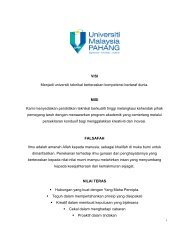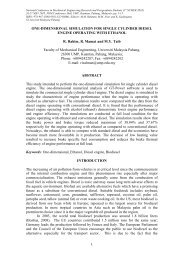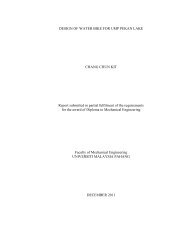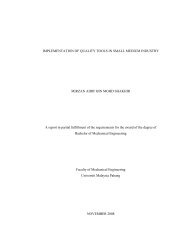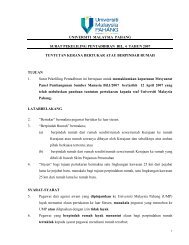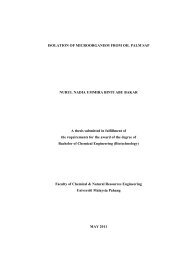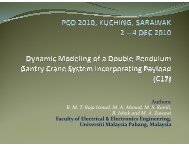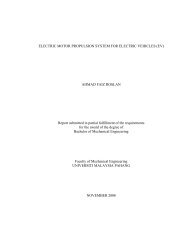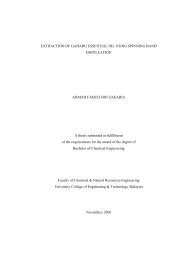experimental determination of convective heat transfer coefficient in ...
experimental determination of convective heat transfer coefficient in ...
experimental determination of convective heat transfer coefficient in ...
Create successful ePaper yourself
Turn your PDF publications into a flip-book with our unique Google optimized e-Paper software.
EXPERIMENTAL DETERMINATION OF CONVECTIVE HEAT TRANSFERCOEFFICIENT IN WIRE ELECTRO DISCHARGE MACHININGNADIAH WAZNAH BINTI ZABIDIA report submitted <strong>in</strong> partial fulfilment <strong>of</strong> the requirementsfor the award <strong>of</strong> the degree <strong>of</strong>Bachelor <strong>of</strong> Mechanical Eng<strong>in</strong>eer<strong>in</strong>gFaculty <strong>of</strong> Mechanical Eng<strong>in</strong>eer<strong>in</strong>gUNIVERSITI MALAYSIA PAHANGNOVEMBER 2008
iiSUPERVISOR’S DECLARATIONWe hereby declare that we have checked this project and <strong>in</strong> our op<strong>in</strong>ion this project issatisfactory <strong>in</strong> terms <strong>of</strong> scope and quality for the award <strong>of</strong> the degree <strong>of</strong> Bachelor <strong>of</strong>Mechanical Eng<strong>in</strong>eer<strong>in</strong>gSignature: …………………………..Name <strong>of</strong> Supervisor :Position :Date :Signature: ………………………….Name <strong>of</strong> Panel :Position :Date :
iiiSTUDENT’S DECLARATIONI hereby declare that the work <strong>in</strong> this thesis is my own except for quotations andsummaries which have been duly acknowledged. The thesis has not been acceptedfor any degree and is not concurrently submitted for award <strong>of</strong> other degree.Signature : ………………….Name : NADIAH WAZNAH BINTI ZABIDIID Number : MA 05045Date :
ivACKNOWLEDGEMENTSFirst I would like to express my grateful to Allah s.w.t. as for the bless<strong>in</strong>g giventhat I can f<strong>in</strong>ish my project.In prepar<strong>in</strong>g this thesis, I was contact with many people and academicians <strong>in</strong>help<strong>in</strong>g me complet<strong>in</strong>g this project. They have contributed toward my understand<strong>in</strong>g, andalso guidance. First, I wish to express my s<strong>in</strong>cere appreciation to my ma<strong>in</strong> thesissupervisor Mdm Mas Ayu B<strong>in</strong>ti Hassan, for encouragement, valuable guidance,constructive criticism, advices, suggestion and motivation throughout this thesis. Withouther cont<strong>in</strong>ued support and <strong>in</strong>terest, this thesis would not have been the same as presentedhereMy s<strong>in</strong>cere also extends to all my beloved family especially my father Zabidi B<strong>in</strong>Abd Rashid and my mother Siti Hasnah Bt Sheikh Mokhs<strong>in</strong> because <strong>of</strong> if not their prayerand support I would not be here and done this thesis. More over I would like to thanks forall my colleagues and others who provides assistance at various occasions. Their viewand tips are useful <strong>in</strong>deed <strong>in</strong> help<strong>in</strong>g me to achieve do<strong>in</strong>g this thesis.
vABSTRACTWire electro discharge mach<strong>in</strong><strong>in</strong>g (WEDM) is a fully extended and competitivemach<strong>in</strong><strong>in</strong>g process widely used to produce dies and moulds. However, the risk <strong>of</strong> wirebreakage affects adversely the full potential <strong>of</strong> WEDM s<strong>in</strong>ce the overall processefficiency is considerably reduced. These symptoms are especially related to theoccurrence <strong>of</strong> an <strong>in</strong>crease <strong>in</strong> discharge energy, peak current, as well as <strong>in</strong>creases ordecreases <strong>in</strong> ignition delay time. Because <strong>of</strong> that, an <strong>experimental</strong> <strong>determ<strong>in</strong>ation</strong> method<strong>of</strong> the <strong>convective</strong> <strong>heat</strong> <strong>transfer</strong> <strong>coefficient</strong> <strong>in</strong> wire electro discharge mach<strong>in</strong><strong>in</strong>g is<strong>in</strong>troduced to prevent the wire breaks dur<strong>in</strong>g runn<strong>in</strong>g the mach<strong>in</strong>e. Parameters such aspeak current and flush<strong>in</strong>g pressure are studied. A special device is developed to measurethe average temperature <strong>in</strong>crement <strong>of</strong> the wire after a period <strong>of</strong> short circuit discharges,and the thermal load imposed on the wire is also tracked and recorded <strong>in</strong> advance. Then,based on the thermal model <strong>of</strong> the wire, the <strong>convective</strong> <strong>coefficient</strong> can be calculatedaccurately. Some tun<strong>in</strong>g experiments are carried out <strong>in</strong>side and outside a previously cutpr<strong>of</strong>ile to exam<strong>in</strong>e the <strong>in</strong>fluence <strong>of</strong> the kerf on the <strong>convective</strong> <strong>coefficient</strong>. With thismethod, the effect <strong>of</strong> the coolant flush<strong>in</strong>g pressure on the <strong>convective</strong> <strong>coefficient</strong> can beestimated. Based on the results <strong>of</strong> the analyses, this paper contributes to improve theprocess performance through a wire breakage.vi
ABSTRAKMes<strong>in</strong> wayar nyahcas elektrik (WEDM) adalah mes<strong>in</strong> yang sangat kompetitif dandigunakan secara meluas dalam menghasilkan acuan. Walau bagaimanapun, risikopemutusan wayar memberi kesan kepada potensi WEDM apabila keseluruhan kecekapanproses semak<strong>in</strong> berkurangan. Simptom <strong>in</strong>i berkaitan dengan kejadian pen<strong>in</strong>gkatannyahcas tenaga, arus yang t<strong>in</strong>ggi dan juga pen<strong>in</strong>gkatan serta pengurangan penangguhanmasa nyalaan percikan elektrik. Oleh sebab itu, eksperimen kaedah penentuan pemalarperalihan haba secara perolakan dalam WEDM diperkenalkan bagi mengelakkanpemutusan wayar berlaku semasa mengendalikan mes<strong>in</strong>. Faktor pengehad seperti arusdan tekanan simbahan penyejuk juga dikaji. Purata kenaikan suhu wayar selepas nyahcaslitar p<strong>in</strong>tas dan beban haba yang dikenakan pada wayar dicatat. Kemudian berdasarkanmodel haba, pemalar perolakan haba dapat di tentukan dengan tepat. Beberapaeksperimen dijalankan untuk mengkaji kesan laluan pemotongan bahan ke atas pemalarperalihan haba secara perolakan. Tekanan simbahan penyejuk juga digunakan semasaeksperimen dan kesan tekanan simbahan <strong>in</strong>i ke atas pemalar peralihan haba secaraperolakan juga dikaji.
viiTABLE OF CONTENTSPageSUPERVISOR’S DECLARATIONiiSTUDENT’S DECLARATIONiiiACKNOWLEDGEMENTSivABSTRACTvABSTRAKviTABLE OF CONTENTSviiLIST OF TABLESxiLIST OF FIGURESxiiLIST OF SYMBOLS xiiiLIST OF ABBREVIATIONSxxCHAPTER 1INTRODUCTION1.1 Research Background 11.3 Problem Statement 21.3 Project Objectives 21.4 Project Scopes 2CHAPTER 2LITERATURE REVIEW2.1 Introduction <strong>of</strong> WEDM 32.22.32.42.5WEDM FunctionWEDM Operat<strong>in</strong>g System2.3.1 Operation Panel 52.3.2 Dielectric Fluid 6Mill<strong>in</strong>g Mach<strong>in</strong>eMaterial2.5.1 Wire Materials44799
viii2.5.2 Mechanical Properties <strong>of</strong> Brass Wire 102.5.3 Workpiece Material 112.5.4 Temperature Distribution for Brass Wire Material 122.6 Convective Heat Transfer 122.6.1 Forced Convection 132.6.2 Free Convection 142.6.3 Convective Heat Transfer Coeficient 142.7 Kerf 162.8 Coolant Flush<strong>in</strong>g Pressure 17CHAPTER 3METHODOLOGY3.1 Introduction 183.1.1 Experiment Flowchart 203.2 Identify Process 213.3 Experiment 243.3.1 Experimental Determ<strong>in</strong>ation <strong>of</strong> the Joule Heat Flux 243.3.2 Experimental System for Determ<strong>in</strong><strong>in</strong>g the Average 26Temperature Increment <strong>of</strong> the Wire3.4 Data Collection 27CHAPTER 4RESULT AND DISCUSSION4.1 Output Voltage 294.2 Temperature Increment 334.3 Temperature with Different Flush<strong>in</strong>g Pressure 354.4 Effect <strong>of</strong> the Kerf on the Convective Coefficient 36
ixCHAPTER 5CONCLUSION AND RECOMMENDATION5.1 Conclusion 385.2 Recommendation 39REFERENCES 40APPENDIX 41
LIST OF TABLESTable No.Page2.1 Composition <strong>of</strong> Brass 102.2 Mechanical Properties <strong>of</strong> Brass 102.3 Composition <strong>of</strong> AISI 4140 Steel 112.4 Typical values <strong>of</strong> <strong>convective</strong> <strong>heat</strong> <strong>transfer</strong> <strong>coefficient</strong> 142.5 Rough estimation <strong>of</strong> the <strong>convective</strong> <strong>coefficient</strong> 162.6 The effect <strong>of</strong> kerf on the <strong>convective</strong> <strong>coefficient</strong> h 172.7 The effect <strong>of</strong> flush<strong>in</strong>g pressure on the <strong>convective</strong> <strong>coefficient</strong> h 173.1 Short circuit current with different peak current 253.2 Factor levels for WEDM 273.34.1Input and Output DataOutput voltage <strong>of</strong> temperature measurement system for 200A28294.2 Output voltage <strong>of</strong> temperature measurement system for 300A 314.3 Output voltage <strong>of</strong> temperature measurement system for 400A 324.4 Temperature measurement with different peak current value andkerf conditions (Flush<strong>in</strong>g pressure = 0.8Mpa)4.5 Temperature measurement with different peak current value andkerf conditions (Flush<strong>in</strong>g pressure = 0.1Mpa)33344.6 The effect <strong>of</strong> kerf on the <strong>convective</strong> <strong>coefficient</strong> h 36
xiiLIST OF FIGURESFigure No.Page2.1 Wire electro discharge mach<strong>in</strong><strong>in</strong>g (WEDM) 32.2 Conventional 2D WEDM operation 52.32.4Operation panel <strong>of</strong> WEDMMill<strong>in</strong>g mach<strong>in</strong>e582.5 Brass material 92.6 Temperature distribution for brass wire material 122.7 Flow <strong>of</strong> material through pressure difference 133.1Flowchart outl<strong>in</strong><strong>in</strong>g the steps taken <strong>in</strong> the project193.2Flowchart <strong>of</strong> experiment 203.3 Thermal model for the WEDM process 213.43.5U I (t) with different Ip sett<strong>in</strong>gSpecimen with dimension 200mm x 40mm x 15mm25274.1 Voltage versus time for peak current 200A 304.2 Voltage versus time for peak current 300A 314.3 Voltage versus time for peak current 400A 324.46.16.26.36.4Temperature <strong>in</strong>crement versus peak current with different flush<strong>in</strong>gpressureWEDMMill<strong>in</strong>g Mach<strong>in</strong>eAISI 4140 Steel (Before cutt<strong>in</strong>g)AISI 4140 Steel (After cutt<strong>in</strong>g)3541414242
xiiiLIST OF SYMBOLSh Convective <strong>heat</strong> <strong>transfer</strong> <strong>coefficient</strong>, W/ (m 2 K)xtTCoord<strong>in</strong>ate along wire axis, mTime coord<strong>in</strong>ate, sTemperature <strong>in</strong>crement along the wire at any time, Kρ Mass density, kg/m 3c Specific <strong>heat</strong>, J/(kg K)VwWire transport<strong>in</strong>g speed, m/sλ Thermal conductivity <strong>of</strong> wire material, W/(m K)av Thermal diffusivity <strong>of</strong> wire material, m 2 /sLCircumference <strong>of</strong> the wire, mS Cross section area <strong>of</strong> the wire, m 2nq ’’’q ’’’ Jq ’’’ dx 1 , x 4x 2 , x 3∆TarI S (t)= hL/SHeat flux density, W/mJoule <strong>heat</strong> flux density, W/mDischarge <strong>heat</strong> flux density, W/mCoord<strong>in</strong>ates <strong>of</strong> the current supply<strong>in</strong>g positionsCoord<strong>in</strong>ates <strong>of</strong> the top and bottom edge <strong>of</strong> the workpieceAverage temperature <strong>in</strong>crement, KRadius <strong>of</strong> the wireValue <strong>of</strong> the short circuit current, A
xxLIST OF ABBREVIATIONSWEDMAISIWire electro discharge mach<strong>in</strong><strong>in</strong>gAmerican iron steel <strong>in</strong>stitute
CHAPTER 1INTRODUCTION1.1 RESEARCH BACKGROUNDWire electrical discharge mach<strong>in</strong><strong>in</strong>g (WEDM) is an adaptation <strong>of</strong> the basicEDM process, which can be used for cutt<strong>in</strong>g complex two and three dimensionalshapes through electrically conduct<strong>in</strong>g materials. WEDM utilizes a th<strong>in</strong>,cont<strong>in</strong>uously mov<strong>in</strong>g wire as an electrode [10]. It is a relatively new process andapplications have grown rapidly, particularly <strong>in</strong> the tool mak<strong>in</strong>g field. The wireelectrode is drawn from a supply reel and collected on a take up reel. Thiscont<strong>in</strong>uously delivers fresh wire to the work area. The wire is guided by sapphire ordiamond guides and kept straight by high tension, which is important to avoidtaper<strong>in</strong>g <strong>of</strong> the cut surface [6]. High frequency dc pulses are delivered to the wire andworkpiece, caus<strong>in</strong>g spark discharges <strong>in</strong> the narrow gap between the two. A stream <strong>of</strong>dielectric fluid is directed, usually coaxially with the wire, to flood the gap betweenthe wire and the workpiece [7]. The power supplies for WEDM are essentially thesame as for conventional EDM, except the current carry<strong>in</strong>g capacity <strong>of</strong> the wirelimits currents to less than 20A, with 10A or less be<strong>in</strong>g most normal. WEDM is mostcommonly used for the fabrication <strong>of</strong> press stamp<strong>in</strong>g dies, extrusion dies, powdercomposition dies, pr<strong>of</strong>ile gages and templates [10].
21.2 PROBLEM STATEMENTIn WEDM process, the <strong>heat</strong> generated by cont<strong>in</strong>uous discharges will lead tothe temperature <strong>in</strong>crement and local erosion <strong>of</strong> the wire and consequently lower itstensile strength. Contradictorily, it is necessary to keep the wire tension at high level<strong>in</strong> order to guarantee the mach<strong>in</strong><strong>in</strong>g accuracy. To prevent the wire from break<strong>in</strong>g, themach<strong>in</strong><strong>in</strong>g processes must take place <strong>in</strong> ionized water bath which not only aids <strong>in</strong> thespark<strong>in</strong>g mechanism, but also helps cool<strong>in</strong>g the wire. The accurately determ<strong>in</strong>ed<strong>convective</strong> <strong>heat</strong> <strong>transfer</strong> <strong>coefficient</strong> will lead to exact analysis and hence will behelpful for the prediction <strong>of</strong> the wire breakage.1.3 PROJECT OBJECTIVESThe objectives <strong>of</strong> this project :i) To determ<strong>in</strong>e the <strong>convective</strong> <strong>heat</strong> <strong>transfer</strong> <strong>coefficient</strong> <strong>in</strong> WEDM.ii) To discover the effect <strong>of</strong> the kerf on the <strong>convective</strong> <strong>coefficient</strong>.iii) To <strong>in</strong>vestigate the effect <strong>of</strong> the flush<strong>in</strong>g pressure on the <strong>convective</strong><strong>coefficient</strong>.1.4 PROJECT SCOPESThis project concentrates on determ<strong>in</strong><strong>in</strong>g the <strong>convective</strong> <strong>heat</strong> <strong>transfer</strong><strong>coefficient</strong> <strong>in</strong> WEDM us<strong>in</strong>g brass wire material with diameter 0.2mm. Theworkpiece use <strong>in</strong> this project is AISI 4140 with diemension ( 200mm x 40mm x15mm). The values <strong>of</strong> the <strong>convective</strong> <strong>coefficient</strong> change with the kerf conditions and<strong>in</strong> the presence <strong>of</strong> coolant flush<strong>in</strong>g pressure.
CHAPTER 2LITERATURE REVIEW2.1 INTRODUCTION OF WEDMWire-electro discharge mach<strong>in</strong><strong>in</strong>g is a process <strong>of</strong> material removal <strong>of</strong>electrically conductive materials by the thermo-electric source <strong>of</strong> energy [3]. Thematerial removal by controlled erosion through a series <strong>of</strong> repetitive sparks betweenelectrodes, workpiece and tool. The electrode is a th<strong>in</strong> wire and it is pulled throughthe workpiece from a supply spool onto a take up mechanism [2,3]. On application <strong>of</strong>a proper voltage, discharge occurs between the wire electrode and the workpiece <strong>in</strong>the presence <strong>of</strong> a flood <strong>of</strong> deionized water <strong>of</strong> high <strong>in</strong>sulation resistance[4]. WEDMus<strong>in</strong>g small diameter wires permits extremely narrow slots to be mach<strong>in</strong>ed <strong>in</strong> theworkpiece, and the kerf is only slighter wider than the wire diameter.Figure 2.1 Wire Electro-Discharge Mach<strong>in</strong><strong>in</strong>g [4]
42.2 WEDM FUNCTIONWEDM has advanced quickly with the addition <strong>of</strong> computer numericalcontrol (CNC). Today WEDM is used for a wide variety <strong>of</strong> precision metalwork<strong>in</strong>gapplications which would have been almost impossible just a few years ago [8].Cutt<strong>in</strong>g tolerances, cutt<strong>in</strong>g speeds and surface f<strong>in</strong>ish quality have been greatlyimproved [11]. Wire-cut EDM can do th<strong>in</strong>gs older technologies cannot do as well, asquickly, as <strong>in</strong>expensively, and as accurately. Most parts can now be programmed andproduced as a solid, rather than <strong>in</strong> sections and then assembled as a unit thatnecessary. The WEDM is capable <strong>of</strong> produc<strong>in</strong>g complex shapes such as tapers,<strong>in</strong>volutes, parabolas and ellipses that would otherwise be difficult to produce withconventional cutt<strong>in</strong>g tools [14,15].2.3 WEDM OPERATING SYSTEMFigure 2.2 below shows the basic operat<strong>in</strong>g <strong>of</strong> the WEDM mach<strong>in</strong>e. TheWEDM move the workpiece along the X and Y axes ( backward, forward, andsideways) <strong>in</strong> a horizontal plane toward a vertically mov<strong>in</strong>g wire . Dur<strong>in</strong>g the cutt<strong>in</strong>gaction, an arc gap <strong>of</strong> 0.02mm to 0.05mm is ma<strong>in</strong>ta<strong>in</strong>ed between the workpiece andthe wire electrode [7]. The eroded material caused by the spark is then washed awayby the dielectric fluid. The WEDM process, as shown <strong>in</strong> Figure 2.2 also generates thedesired shape by us<strong>in</strong>g electrical sparks between a th<strong>in</strong>, travel<strong>in</strong>g brass wire electrodeand workpiece to erode a path <strong>in</strong> the workpiece material [6,7]. It also showscont<strong>in</strong>uous electrical sparks be<strong>in</strong>g generated between the wire and workpiece formaterial removal. The cutt<strong>in</strong>g force generated <strong>in</strong> WEDM is small, which makes itsuitable for manufactur<strong>in</strong>g m<strong>in</strong>iature features and micro-mechanical components [7].
52.3.1 Operation PanelFigure 2.2 Conventional 2D WEDM operation [2]Figure 2.3 Operation panel <strong>of</strong> WEDM [2]
6(1) LCD screen (13) [TANKDRAIN ON/OFF](2) Emergency stop switch (14) [TANK DOOR](3) Keyboard (15) Switches [A0] to [A7](4) Floppy disc drive (16) [MFR0] to [MFR3](5) [SOURCE ON/OFF] switches (17) [OFF] switch(6) [POWER ON/OFF] switches (18) [ACK] switch(7) [AWT CUT/TREAD] switch (19) [HALT] switch(8) [TENSION ON/OFF] switches (20) [ENT] switch(9) [WIRE STOP/RUN] switches (21) [ST] switch(10) [HIGH PRESSURE ON/OFF] switches (22) [UV] switch(11) [LOW PRESSURE ON/OFF] switches (23) Jog switches(12) [TANK FILL ON/OFF]2.3.2 Dielectric FluidOne <strong>of</strong> the most important factors <strong>in</strong> a successful WEDM operation is theremoval <strong>of</strong> the particles (chips) from the work<strong>in</strong>g gap. Flush<strong>in</strong>g these particles out <strong>of</strong>the gap with the dielectric fluid will produce good cutt<strong>in</strong>g conditions, while poorflush<strong>in</strong>g will cause erratic cutt<strong>in</strong>g and poor mach<strong>in</strong><strong>in</strong>g conditions [10].The dielectric fluid <strong>in</strong> the WEDM process is usually deionized water. This istap water that is circulated through an ion-exchange res<strong>in</strong>. The deionized watermakes a good <strong>in</strong>sulator, while untreated water is a conductor and is not suitable forthe electrical discharge mach<strong>in</strong><strong>in</strong>g process[11,13]. The amount <strong>of</strong> deionization <strong>of</strong> thewater determ<strong>in</strong>es its resistance. For most operations, the lower the resistance thefaster will be the cutt<strong>in</strong>g speed [10].
7The dielectric fluid used <strong>in</strong> the WEDM process serves several functions :1. It helps to <strong>in</strong>itiate the spark between the wire and the workpiece [2].2. It serves as an <strong>in</strong>sulator between the wire and the workpiece [2].3. It flushes away the particles <strong>of</strong> dis<strong>in</strong>tegrated wire and workpieceto prevent short<strong>in</strong>g [3].4. It acts as a coolant for both the wire and the workpiece [3].2.4 MILLING MACHINEA mill<strong>in</strong>g mach<strong>in</strong>e is a mach<strong>in</strong>e tool used for the shap<strong>in</strong>g <strong>of</strong> metal and othersolid materials. Its basic form is that <strong>of</strong> a rotat<strong>in</strong>g cutter which rotates about thesp<strong>in</strong>dle axis (similar to a drill), and a table to which the workpiece is affixed. Incontrast to drill<strong>in</strong>g, where the drill is moved exclusively along its axis, the mill<strong>in</strong>goperation <strong>in</strong>volves movement <strong>of</strong> the rotat<strong>in</strong>g cutter sideways as well as <strong>in</strong> and out[14].The cutter and workpiece move relative to each other, generat<strong>in</strong>g a tool pathalong which material is removed. The movement is precisely controlled, usually withslides and lead screws or analogous technology [13]. Often the movement isachieved by mov<strong>in</strong>g the table while the cutter rotates <strong>in</strong> one place, but regardless <strong>of</strong>how the parts <strong>of</strong> the mach<strong>in</strong>e slide, the result that matters is the relative motionbetween cutter and workpiece. Mill<strong>in</strong>g mach<strong>in</strong>es may be manually operated,mechanically automated, or digitally automated via CNC [14].Mill<strong>in</strong>g mach<strong>in</strong>es can perform a vast number <strong>of</strong> operations, some <strong>of</strong> themwith quite complex tool paths, such as slot cutt<strong>in</strong>g, plan<strong>in</strong>g, drill<strong>in</strong>g, dies<strong>in</strong>k<strong>in</strong>g,rebat<strong>in</strong>g and rout<strong>in</strong>g. Cutt<strong>in</strong>g fluid is <strong>of</strong>ten pumped to the cutt<strong>in</strong>g site to cool andlubricate the cut, and to sluice away the result<strong>in</strong>g swarf.[14].
8Figure 2.4 Mill<strong>in</strong>g mach<strong>in</strong>e [14]Most CNC mill<strong>in</strong>g mach<strong>in</strong>es or mach<strong>in</strong><strong>in</strong>g centers are computer controlledvertical mills with the ability to move the sp<strong>in</strong>dle vertically along the Z-axis. Thisextra degree <strong>of</strong> freedom permits their use <strong>in</strong> die s<strong>in</strong>k<strong>in</strong>g, engrav<strong>in</strong>g applications, and2D surfaces such as relief sculptures [13]. When comb<strong>in</strong>ed with the use <strong>of</strong> conicaltools or a ball nose cutter, it also significantly improves mill<strong>in</strong>g precision withoutimpact<strong>in</strong>g speed, provid<strong>in</strong>g a cost-efficient alternative to most flat-surface handengrav<strong>in</strong>gwork [11].CNC mach<strong>in</strong>es can exist <strong>in</strong> virtually any <strong>of</strong> the forms <strong>of</strong> manual mach<strong>in</strong>ery,like horizontal mills. The most advanced CNC mill<strong>in</strong>g-mach<strong>in</strong>es, the 5-axismach<strong>in</strong>es, add two more axes <strong>in</strong> addition to the three normal axes (XYZ). Horizontalmill<strong>in</strong>g mach<strong>in</strong>es also have a C or Q axis, allow<strong>in</strong>g the horizontally mountedworkpiece to be rotated, essentially allow<strong>in</strong>g asymmetric and eccentric turn<strong>in</strong>g [13]
92.5 MATERIALS2.5.1 Wire MaterialsThe wire material used <strong>in</strong> this project is made <strong>of</strong> brass, which is an idealmaterial for the thermal resistance. It is an alloy <strong>of</strong> copper and z<strong>in</strong>c that has goodcorrosion resistance and is easily formed, mach<strong>in</strong>ed and cast [9]. Copper is the ma<strong>in</strong>component, and brass is usually classified as a copper alloy. The color <strong>of</strong> brass variesfrom a dark reddish brown to a light silvery yellow depend<strong>in</strong>g on the amount <strong>of</strong> z<strong>in</strong>cpresent. The more z<strong>in</strong>c, the lighter the color. Brass is stronger and harder thancopper, but not as strong or hard as steel [6]. It is easy to form <strong>in</strong>to various shapes, agood conductor <strong>of</strong> <strong>heat</strong>, and generally resistant to corrosion from salt water. Because<strong>of</strong> these properties, brass is used to make pipes and tubes, weather-stripp<strong>in</strong>g andother architectural trim pieces, screws, radiators, musical <strong>in</strong>struments, and cartridgecas<strong>in</strong>gs for firearms [9]. It has consistent tensile strength which is the <strong>heat</strong> treated forstable tensile strength to avoid the wire breakage [1].Figure 2.5 Brass material [3]
102.5.2 Mechanical Properties <strong>of</strong> Brass WireTable 2.1 : Compositon <strong>of</strong> Brass [12]ComponentWt.%C 60 - 63Zn 35.5Pb 2.5 - 3.7Fe Max 0.35Other Max 0.5Brass consists <strong>of</strong> five elements which copper has the highest percentage <strong>of</strong>the composition. The percentage is between 60 to 63 percent and it follows by z<strong>in</strong>c.The percentage <strong>of</strong> z<strong>in</strong>c element <strong>in</strong> brass is 35.5 percent and follows by lead 2.5 to 3.7percent, iron 0.35 percent and other element is 0.5 percent [12].Table 2.2 : Mechanical Properties <strong>of</strong> Brass [12]Mechanical PropertiesMetricUltimate Tensile Strength 338 – 469 MpaTensile Strength, Yield 124 – 310 MpaElongation at Break 53%Modulus <strong>of</strong> Elasticity97 GpaBulk Modulus140 GpaPoisson’s Ratio 0.31Mach<strong>in</strong>ability 100%Shear Modulus37 GpaTable 2.2 shows mechanical properties <strong>of</strong> brass. Brass has Ultimate TensileStrength between 338 to 469 Mpa and Tensile Strength , Yield varies from 124 to310 Mpa. The elongation at break is 53%, Modulus <strong>of</strong> Elasticity 97 Gpa and BulkModulus is 140 Gpa. The Poisson’s Ratio <strong>of</strong> brass is 0.31, Shear Modulus 37 Gpaand it has 100% mach<strong>in</strong>ability [12].



